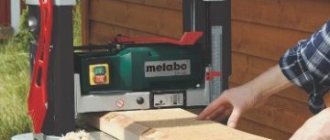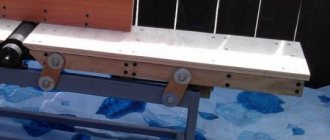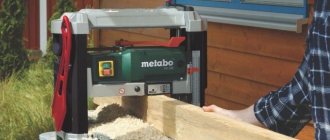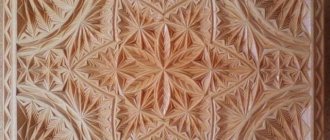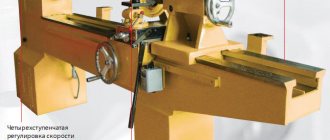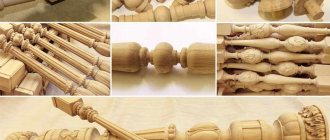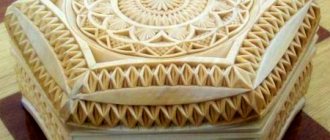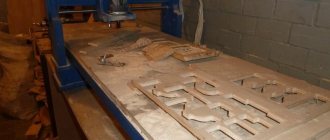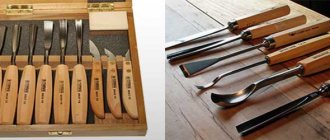Wood carving is one of the oldest types of applied art, which has not lost its popularity today. Artistic carving is a very labor-intensive and complex, but very exciting activity, which requires special tools - wood cutters.
There are a large number of types and shapes of these tools, designed for different cutting methods, depending on the specific areas of the relief of the wooden workpiece. The cleanliness of the carving depends on their quality no less than on the skill of the carver.
How to make a chisel from scrap materials?
The name of this device comes from the German word Stemmeisen, which translates as “slotting tool”, “tool for hollowing out”. This term meant a thin instrument that was moved by hand, without the use of a mallet. This term came to Russia, presumably, under Peter I and meant a device that now falls under the definition of “chisel,” i.e. item for chiselling.
Chisels for wood carving consist of a handle and a metal blade . In the recent past, when more often than not you had to “get” everything, rather than buy it, many craftsmen made such household items for themselves. In addition, it was not always possible to find the tool needed “here and now.” You can make blades for homemade chisels from decommissioned saws from any sawmill. Both disc and flat blades are suitable. A workpiece is cut out of a piece of saw using a grinder, then processed, sharpened, and then a handle is attached.
There are craftsmen who make fabric from the outer race of a bearing. To do this, the clip is cut into two parts, heated to orange and straightened with a hammer on an anvil. Two blanks emerge from the resulting plate. How to make a chisel with a rounded cutting edge will become clear if you look at the pipe. You will have to cut hardened metal, and therefore, when using a grinder, you must remember that at high speed and continuous cutting, tempering of the metal may occur, so the workpiece should not be allowed to overheat.
Sharpening of chisels, that is, their cutting edge, should be done using sandpaper, at low speed, with periodic wetting with water. The metal must not be allowed to overheat, otherwise the entire workpiece will be hopelessly damaged.
Types of chisels based on operating principle
Currently, tool factories produce, and numerous stores sell a huge amount of the tools under discussion. Based on the principle of operation, we distinguish the following types of chisels:
- those that cut without the help of additional tools, using only hand strength; such devices are made in small sizes, with a thinner metal part; You can work with them on any wood, it’s convenient to cut out small details and patterns.
- larger options that can be worked with manual effort, and if necessary, you can use a mallet; A metal ring is placed on the handle of such chisels, and wooden, rubber and polyurethane mallets can be used.
- varieties that are used only with the help of a mallet; usually such chisels come in large sizes; they process hardwood, the handle of the chisel must be looped, otherwise it will quickly fail.
Chisels for wood and lathe
Special, specific tools are made for wood carving; with their help, craftsmen create unique panels, wood and linoleum engravings. A set of chisels for such work is produced with a wide variety of cutting edge shapes. There are spoon cutters, their blades are made curved along the entire length, they are intended for making round deep depressions in wood. They got their name because they were originally used to make spoons, bowls, scoops and other kitchen utensils. Now there is a wider application, however, sets of dishes and spoons with Khokhloma painting are still popular.
Wood lathes are used to produce a large number of similar products. Chisels for a lathe can be manual or caliper (cutters). A hand tool should have a long, thick handle that allows you to hold it firmly and work at a fairly safe distance. The direction and force of cutting are determined by the hand of the master. Caliper chisels are made much shorter and do not have a handle. Feed and speed are carried out through a caliper; the drive can be mechanical or electrical. Turning cutters can be bought in stores either individually or as a set. Tool sets for lathes are produced in a wide variety of sizes and modifications. And at different prices, depending on the method and quality of manufacturing the metal and the tool itself.
Types of incisors
All wood cutters necessary for manual work have the same design and consist of a metal blade with a shank on which a wooden handle is attached.
To cut simple geometric patterns on a flat surface, you can get by with a couple of simple cutters, but to create complex volumetric and openwork works from wood, you will need to use a large number of special cutters.
The most widely used types of these instruments are:
- jamb knife - a tool like a shoe knife with a short triangular blade, the bevel angle of which can be different, which makes it universal and suitable for a wide range of jobs;
- The chisel is the most common type of wood cutter. It performs the bulk of the work when creating most carved products; it has a smooth blade with a cutting edge at the end, which can be straight, oblique, semicircular or angled in the shape of the letter V;
- cranberry - a tool similar to a chisel, with a blade that has two bends of one hundred and twenty degrees (so that the handle does not catch the plane being processed when working). With a variety of cutting parts - semicircular, bracket, straight and others;
- spoon cutter - a cutter for cutting spoons and other utensils, made in the shape of a ring or half ring with a sharpened side edge;
- a hatchet is a knife that looks like a slightly beveled ax blade, which is a fairly universal tool, the corners of which can make cuts both towards you and away from you, and with the middle of the blade you can cut off bulges.
For those who are just starting to master the technique of wood carving, at first it will be enough to buy 5-6 cutters - a jamb knife, a flat chisel and two semicircular and corner ones with different radii and bending angles. But you need to take high-quality, professional tools, despite their rather high price. Cheap kits for beginners are made of poor steel, they become dull very quickly and working with them will not bring pleasure to the carver.
Experienced craftsmen prefer to make wood cutters for themselves. Making them is not very difficult and can be done by anyone, even at home.
Choosing a set of chisels for all occasions
Before purchasing chisels, first of all, you need to decide what they are needed for. If this purchase is for a one-time job (repairing windows in an apartment), you can buy an inexpensive set that will not be needed for several years. If wood carving is your life’s work, then the choice of tool must be taken with full responsibility. According to the manufacturing method, chisels are forged, cut and stamped. Forged ones have a thicker blade, which allows you to work with harder materials.
Punching machines allow you to maintain high precision when working with materials of lower density and hardness. It is necessary to install thrust washers on stamped chisels so that the handles do not “sit” on the shank when struck by the mallet. Depending on the type of handle fastenings, chisels are produced with mounted cones-skirts and with shanks. Options with a cone mount are better able to withstand fairly strong lateral and impact loads. They also better resist twisting and bending when making holes if used as a lever. The length of the chisel matters: optimally 10-15 cm.
With a longer length, the load that the canvas can withstand decreases. Attention should also be paid to the handles. The handle should be smooth and streamlined. A steel cap should be installed at the end to prevent the wood from flattening. GOST standards provide for handles made from different types of wood, but practice shows that modern plastics last longer and withstand impact loads better than the hardest types of wood.
DIY making
When making these tools, you cannot do without an electric sharpening machine (electric sharpener) with a set of abrasive wheels of different grain sizes. In most operations, it can be successfully replaced by a grinder with cutting and grinding discs.
Wood cutter blade
To make a tool blade, any used high-quality steel products are suitable - springs, drills, scalpels, rasps and even bearing rings.
For knives, the easiest choice is a hacksaw blade. Manufacturing consists of cutting it into pieces of the required length, forming the desired blade shape and sharpening.
The best option for chisels is a circular saw blade, the thickness of which is very suitable for this purpose. The carbon steel from which it is made holds an edge for a long time, even when processing hard wood. Cutting strips of the required size and grinding them to obtain the required blade shape is done using a grinder or an abrasive disc of an electric sharpener.
An old punch is perfect for a semicircular chisel - it already has the desired shape. It is enough just to cut off the excess metal from it and sharpen it.
During intensive grinding, the metal heats up, which causes a tempering, making it softer and unable to maintain an edge for a long time. Therefore, after giving the blade the desired shape and sharpening, hardening is required. To do this, you need to heat the cutting part using a gas or kerosene burner until it turns crimson and lower it into a container with machine oil.
Lever
Oak is considered the most suitable wood for the handle. Well, where it does not grow, it can be quite successfully replaced by birch, which, being burnt black with a gas burner and sanded, does not require any coating and is very comfortable to work with.
For wood knives, the handle can be made in the following way:
- cut two bars about 12 centimeters long and 12x22 millimeters in cross-section;
- attaching the shank of the blade to the block, circle it with a pencil;
- Use a chisel to select wood to the depth of the blade thickness;
- apply wood glue (PVA or EDF can be used) on the surface of the bars, connect the structure and tighten it with clamps or clamp it in a vice;
- After the glue has dried, plan the handle or grind it on an electric grinder and sand it.
For chisels, the handle can be turned on a lathe or cut from a whole block. Then drill a hole to the size of the shank and, having first put a crimp ring on the handle, which protects the wood from splitting, carefully place it on the blade.
Sharpening wood cutters
The final stage in the manufacture of wood cutters is the formation of the cutting part and sharpening. The main part of the metal from the cutting edge can be removed on the abrasive wheel of an electric sharpener or with the sharpening disc of an angle grinder.
The sharpening angles of the chamfers of all types of cutters are approximately the same and lie in the range of 18-25°, and the length of the sharp part is about 20-35 mm, depending on the total length of the cutter. During the processing process, it is necessary to constantly cool the blade in a container with water.
Further work is performed manually in the following sequence:
- sharpening on an emery block, which is recommended to be periodically moistened with water;
- sharpening on a thinner block or on sandpaper placed on a hard, even substrate;
- final editing and polishing of the cutting edge on a leather belt rubbed with GOI paste.
During the operation of a cutting tool, its blade inevitably loses its sharpness. Regular thorough sharpening of wood cutters is a necessary condition for comfortable work of the carver and high quality of the carved product.
